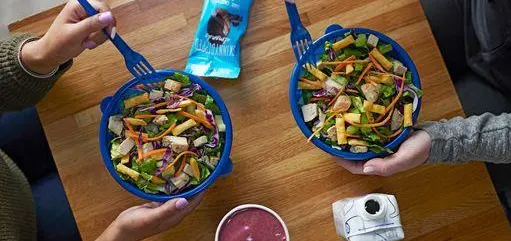
When most of us think of salads, we think of healthy meals that use fresh ingredients, like greens and tomatoes. But even healthy meals can have an unhealthy impact on the planet. Global food systems, including restaurants and their food supply chains, account for about a quarter of global greenhouse gas emissions.
Just Salad is a chain of fast-casual restaurants working to create a zero-waste dining experience, both in-store and through its deliveries. The restaurant has launched numerous sustainability and zero-waste initiatives, such as its reusable bowl program and its carbon-labeled menu. It hopes that others in the food industry, and beyond, will adopt these practices.
“The bigger philosophical point I'm making is why can't this zero-waste and reusable infrastructure also go mainstream in one of the most common of all human experiences, which is eating food and ordering it?” says Sandra Noonan, Chief Sustainability Officer at Just Salad. “So we're trying to build that infrastructure and push the circular economy to the mainstream.”
In a conversation I had with Noonan as part of my research of purpose-driven businesses, she explained how the company’s initiatives work, what impact they have and why Just Salad hopes they will go mainstream.
Chris Marquis: Can you say a little bit about Just Salad’s zero waste work? What exactly do you mean by that and how do you think about your waste production?
Sandra Noonan: Zero-waste dining to us means trash-free eating and decoupling the joyful ritual of eating from trash. I think it's also helpful to define what zero waste itself means, and I have a technical definition that I like to refer to. This is from the Zero Waste International Alliance. They define it as “the conservation of all resources by means of responsible production, consumption, reuse and recovery of products, packaging and materials without burning and no discharges to land, water or air that threaten the environment or human health.”
Zero waste is a tall order, and at Just Salad it centers on our reusable bowl program. In addition to that, we are trying to make zero waste a principle in every other aspect of the eating experience, from utensils to the bag. Customers have to say “yes” or “no” to utensils on orderjustsalad.com, and we don’t provide a bag automatically for takeout or pickup orders. So the accessories around the food container are also a focus for us — but the reusable bowl is the cornerstone of the program.
This is a larger cultural trend. You're seeing reusables taking hold in a lot of consumer sectors. For example, in personal care, Loop and Ulta recently announced a partnership where customers can return their used cosmetics containers to be refilled. The infrastructure for reusables is emerging, from cosmetics to groceries to cleaning products.
The bigger philosophical point I'm making is, why can't this infrastructure also go mainstream in the most common of all human experiences, which is eating food and ordering it? So we're trying to build that infrastructure and push the circular economy to the mainstream.
Marquis: Tell me more about the reusable bowl program. How does it work exactly?
Noonan: The reusable bowl program started on day one at Just Salad, in 2006. In fact, we only offered the Reusable Bowl at first, and that was thanks to our visionary and ambitious CEO and founder Nick Kenner. It turns out he was way ahead of his time, and so we had to bring in disposable options as well. The key to the success of the Reusable Bowl program — 20% of our customers use it — is that we offer a reward. For every use, the customer gets a free salad topping.
The economics of that are interesting because it reaps great dividends for Just Salad in terms of customer loyalty. And while we spend on the free topping, we save on the disposable containers. But now the question is, how do we get that 20% of customers participating up to, say, 80%? One key step in achieving that is making food pickup and delivery zero waste. So far, I've been talking about an on-premise program. But what we're piloting this year is bringing the reusable container to you, and you would return it the next time you go out for a walk and stop by the store. Could you ever give the container back to the delivery courier? It's a reverse logistics challenge we are now trying to figure out.
With the in-store program, the model is buy the bowl, own the bowl, and wash the bowl. With the digital pickup and delivery model we're piloting, you order online, you get the bowl, you drop it off, and we wash and sanitize it. So we are playing around with both models to see what takes hold.
Marquis: You’ve also been putting carbon labels on your menu to show how much carbon is produced by different menu items. Why did you decide to do that?
Noonan: We started researching the best way to engage with our customers on food and climate, as a quarter of global greenhouse emissions result from the food system. And a substantial portion of that is what we choose to eat, so if that's the case, then it means that eaters — all of us — have the ability to take climate action multiple times a day. Fifty-one percent of Americans feel helpless to do anything about climate change, so those two facts don't mesh, and we wanted to change that.
We took inspiration from the nutrition label. Before the ’90s, you didn't have standardized calorie and nutrition labels on food packaging. So we said, “What if the new calorie label is the carbon footprint label?” It’s not a perfect analogy, but why can't there be consumer literacy around carbon? If climate change is an existential threat, and if we really care, where is the consumer education on carbon literacy?
The output of all this thinking was the carbon label on each of our salads and a climatarian menu [on orderjustsalad.com] that curates the lowest emissions items. This is a very ambitious project, and it’s in beta mode.
Marquis: Can you describe the carbon-labeling process, and how it has impacted the company overall?
Noonan: The calculation methodology relies on peer-reviewed academic studies that are collated into databases. You can look up the estimated carbon footprint of a single ingredient, and we did that ingredient by ingredient. Then, for each salad, we tallied up all the ingredients and produced an estimate of greenhouse gas emissions.
Our carbon footprint labels reflect the estimated emissions from agricultural production and transportation. We do not claim to tell you the carbon emissions from every link in the chain. There’s no way to know if a customer threw away some of their food or composted it, for example, and to calculate the carbon emissions of that. We don't calculate the carbon footprint of the packaging, either. Every carbon footprint estimate has a boundary to it, and this is what we're able to do right now.
The impact of the carbon labels internally has been important. When we look at our menu items now and we have their carbon footprint, our culinary director can see, for example, that dairy-based dressing increases the footprint of a salad. It makes us more aware of the impact of each ingredient and it has the potential to influence both culinary decisions and sourcing decisions.
Marquis: How did you ensure that the Reusable Bowl program meets health and safety standards when you’re relying on customers to wash the reusable bowls they own? Especially with the current pandemic, people are particularly conscious of health and sanitation.
Noonan: The reason that it has never resulted in any known health and safety issues over 15 years and millions of transactions is because of our standard operating procedure, which is completely contactless and which we developed in partnership with the health department. Our staff never touches your reusable bowl and your bowl never makes contact with our surfaces. They prepare your salad in the standard metal mixing bowl, and at the end, they dispense it into the reusable bowl using a contactless process. Because of this, some people see this program as even safer than disposable bowls.
Marquis: How much waste does the reusable bowl program divert?
Noonan: Historically — and I say historically because 2020 was such an anomalous year — around 75,000 pounds of single-use waste are diverted annually through the program. In 2020 those numbers dipped because of locally mandated store closures due to Covid. Even so, if you stack all of the disposable bowls we prevented from being used last year one on top of the other, they would be the height of about 20 Empire State Buildings.
